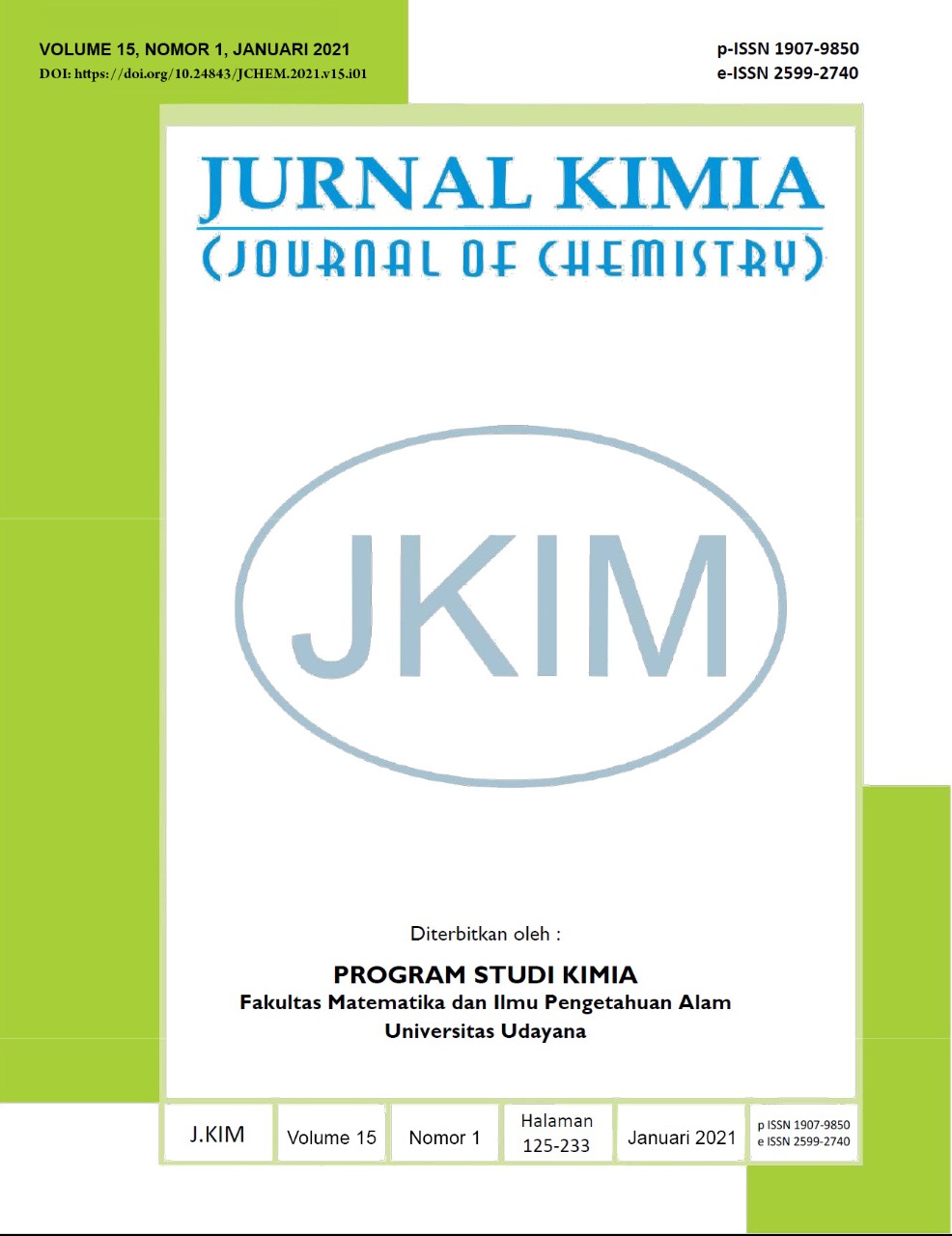PREPARASI ARANG BAMBU DENGAN METODE KONVENSIONAL, AKTIVASI TERMAL DAN KARAKTERISASI SERTA APLIKASINYA SEBAGAI ADSORBEN LOGAM Pb(II) DAN Cr(III)
Abstrak
Arang aktif merupakan adsorben multifungsi, dapat menyerap spesi yang bermuatan positif seperti ion logam, molekul netral seperti I2 dan bermuatan negatif. Tujuan penelitian adalah membuat arang aktif dari limbah bambu yang berguna meminimalisir kandungan logam timbal (II) dan krom (III) dari perairan. Pembuatan arang dilakukan secara konvensional menggunakan tong kedap udara dengan pemanasan selama 12 jam. Aktivasi arang dilakukan menggunakan tanur pada suhu 650oC selama 4 jam. Hasil penelitian menunjukkan bahwa aktivasi termal menghasilkan arang aktif lebih baik dibandingkan tanpa aktivasi. Arang yang diaktivasi dan tanpa aktivasi memenuhi SNI 06-3730-1995 tentang arang aktif teknis. Luas permukaan sebesar 494,8178 m2/g, keasaman permukaan sebesar 4,4426 mmol/g, dan kebasaan permukaan sebesar 3,4467 mmol/g. Kondisi optimum adsorpsi terhadap ion logam yaitu waktu kontak 24 jam dan pH 8 untuk Pb(II) dan pH 6 untuk Cr(III). Kapasitas adsorpsi arang aktif sebesar 3,9800 mg/g untuk ion Pb(II) dan 3,9766 mg/g untuk ion Cr(III).
##plugins.generic.usageStats.downloads##
Referensi
Alothman, Z. A., Habil, M. A., dan Ali, R. 2011. Preparation of Activated Carbon Using the Copyrolysis of Agricultural and Municipal Solid Wastes at a Low Carbonization Temperatur.International Conference on Biology, Environment and Chemistry. 24: 67-72.
Bhattacharyya, K. G., dan Gupta, S. S. 2007. Adsorptive Accumulation of Cd(II), Co(II), Cu(II), Pb(II), and Ni(II) from Waste On Montmorillonite, Influence of Acid Activation. Journal of Colloid and Interface Science. 310: 411-424.
Hartanto, S dan Ratnawati. 2010. Pembuatan Karbon Aktif dari Tempurung Kelapa Sawit dengan Metode Aktivasi Kimia.Jurnal Sains Materi Indonesia. 12(1): 12-16.
Hesas, R. H., Niya, A. A., Daud, M. A, W., Sahu, J. N. 2013. Preparation and Characterization of Activated Carbon from Apple Waste by Microwave-Assisted Phosphoric Acid Activation: Application in Methylene Blue Adsorption. Bioresources 8 (2): 2950-2966.
Igwe, J. C., Ogunewe, D. N., Abia, A. A. 2005. Competitive Adsorption of Zn(II), Cd(II) and Pb(II) Ions from Aqueous and Non-Aqueous Solution by Maize Cob and Husk. African Journal of Biotechnology. 4(10): 1113-1116.
Isagai, H. 2008. Adsorption of Zinc (II) and Copper (II) to Shirasu (Pyroclastic flow).Journal Analytical Science. 24: 395-399.
Kajina, W., Junpen, A., Garivait, S., Kamnoet, O., Keeratiisariyakul, P., Rousset, P. 2019. Charcoal Production Processes: An Overview. Journal of Sustainable Energy and Environment.10: 19-25.
Khuluk, R. H. 2016. Pembuatan dan Karakterisasi Karbon Aktif dari Tempurung Kelapa (Cocos Nucifera,L.) sebagai Adsorben Zat Warna Metilen Biru. Skripsi. Universitas Bandar Lampung.
Krismayanti, N., Manurung, M., Suastuti, N. 2019. Sintesis Arang Aktif dari Limbah Batang Bambu dengan Aktivator NaOH sebagai Adsorben Ion Krom(III) dan Timbal(II). Jurnal Kimia (Journal of Chemistry). 7(2): 189-197. Program Studi Kimia, FMIPA, Universitas Udayana. Bukit Jimbaran.
Kriswiyanti, Enny A., dan Danarto, Y. C. 2007. Model Kesetimbangan Adsorpsi Cr Dengan Rumput Laut. Jurusan Teknik Kimia Fakultas Teknik UNS. Ekuilibrium. 6 (2): 47-52.
Manurung, M., Sahara, S., Sihombing, P. 2019. Pembuatan dan Karakterisasi Arang Aktif dari Batang Bambu Apus (Gigantochloa apus) dengan Aktivator H3PO4. Jurnal Kimia (Journal of Chemistry). 13(1): 16-21, Program Studi Kimia, FMIPA, Universitas Udayana, Bukit Jimbaran.
Muzakkar, M. Z., dan Ratna. 2012. Studi Adsorpsi Ion Logam Timbal (II) dengan Menggunakan Arang Aktif Kulit Biji Jambu Mete. Jurnal Kimia dan Pendidikan Kimia. 1(2) : 132-141.
Ningrum, L. P., Lusiana, R, A., Nuryanto, R. 2008. Dekolorisasi Remazol Brilliant Blue dengan Menggunakan Karbon Aktif. Seminar Tugas Akhir S1. Fakultas MIPA, Universitas Diponegoro. Semarang.
Pari, G. 2009. Laporan Mengikuti 1st Asia Pasific Biochar Conference Gold Coast. Australia. 17-20 Mei 2009. Tidak diterbitkan.
Riani E., Johari H. S., Cordova M.R. 2017. Bioakumulasi logam berat kadmium dan timbal pada kerang kapak-kapak di Kepulauan Seribu.Jurnal Pengolahan Hasil Perikanan Indonesia. 20(1): 131-142.
Standar Nasional Indonesia. 1995. SNI 06-3730-1995; Arang Aktif Teknis. Dewan Standarisasi Nasional. Jakarta

This work is licensed under a Creative Commons Attribution 4.0 International License






